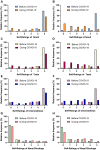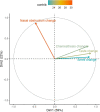Self-reported symptom study of COVID-19 chemosensory dysfunction in Malaysia
- PMID: 35136124
- PMCID: PMC8826975
- DOI: 10.1038/s41598-022-06029-6
Self-reported symptom study of COVID-19 chemosensory dysfunction in Malaysia
Abstract
Alterations in the three chemosensory modalities-smell, taste, and chemesthesis-have been implicated in Coronavirus Disease 2019 (COVID-19), yet emerging data suggest a wide geographic and ethnic variation in the prevalence of these symptoms. Studies on chemosensory disorders in COVID-19 have predominantly focused on Caucasian populations whereas Asians remain understudied. We conducted a nationwide, multicentre cross-sectional study using an online questionnaire on a cohort of RT-PCR-confirmed adult COVID-19 patients in Malaysia between 6 June and 30 November 2020. The aim of our study was to investigate their presenting symptoms and assess their chemosensory function using self-ratings of perceived smell, taste, chemesthesis, and nasal blockage. In this cohort of 498 patients, 41.4% reported smell and/or taste loss when diagnosed with COVID-19, which was the commonest symptom. Blocked nose, loss of appetite, and gastrointestinal disturbances were independent predictors of smell and/or taste loss on multivariate analysis. Self-ratings of chemosensory function revealed a reduction in smell, taste, and chemesthesis across the entire cohort of patients that was more profound among those reporting smell and/or taste loss as their presenting symptom. Perceived nasal obstruction accounted for only a small proportion of changes in smell and taste, but not for chemesthesis, supporting viral disruption of sensorineural mechanisms as the dominant aetiology of chemosensory dysfunction. Our study suggests that chemosensory dysfunction in COVID-19 is more widespread than previously reported among Asians and may be related to the infectivity of viral strains.Study Registration: NMRR-20-934-54803 and NCT04390165.
© 2022. The Author(s).
Conflict of interest statement
The authors declare no competing interests.
Figures


References
Publication types
MeSH terms
Associated data
LinkOut - more resources
Full Text Sources
Medical

